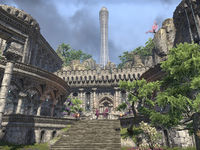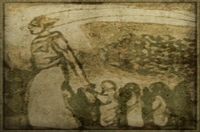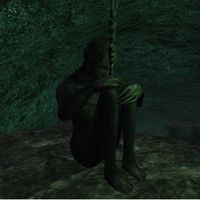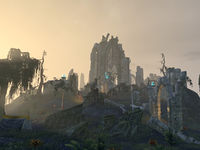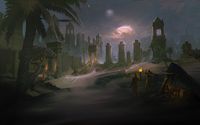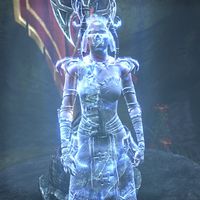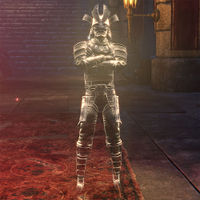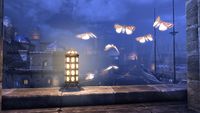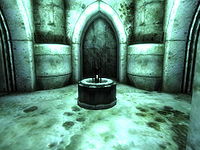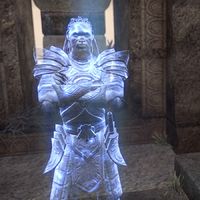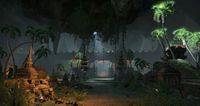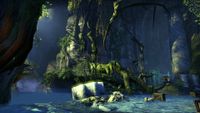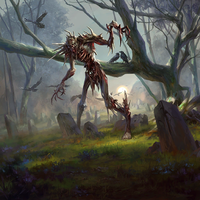Lore:Ancestor Worship
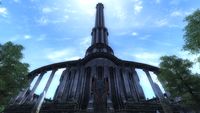
Ancestor worship refers to veneration of the dead based on respect for the deceased. Depending on the culture, it may involve praying to direct family or paying tribute to specific figures of historical importance. Direct communion with, or manifestation of, the dead to provide favors or advice is also a common element.[1]
Ancestor Worship is especially important to elves, many of whom believe themselves to be the direct descendants of et'Ada.[2][3] As the descendants or "children" of the et'Ada, this means they can be considered an extension of the et'Ada, whom live on through their children as the Divine Spark that all carry, and thus Ancestor Worship is worship of the self as well.[UOL 1][4][5] Some traditions even hold that gods are merely exceptionally powerful ancestor spirits.[6] The now common terms Aedra ("our ancestors") and Daedra ("not our ancestors"), were originally specifically used in this context.[7] Nevertheless, aspects of ancestor worship can be found in many cultures all across Nirn.
Altmer[edit]
The early Aldmer followed a strong tradition of ancestor worship, which they had brought with them from Aldmeris to Summerset.[8]
The Crystal Tower was constructed not to honor any king or god, but rather the spirit of the elven people, living and dead. It served both as a shrine for the ancestors and a graveyard for the early Aldmer settlers. This was seen as a fairly egalitarian time politically, as traditions of ancestor worship helped foster communal values.
However, as Aldmer society grew it also grew more stratified, social divisions became increasingly important. This social shift was reflected in Aldmer religion, as emphasis shifted away from worshipping one's own ancestors towards worshipping the ancestors of their "betters". The ancestor spirits of the upper castes grew in popularity, and in time, they were converted into gods. Where once Auri-El had been an ancestor spirit of the nobility, eventually, all the Altmer would claim Auri-El as a common ancestor.[8][2]
Other notable ancestor spirits who survived this shift toward godhood include Trinimac, Syrabane, Xarxes, and Phynaster, all of whom remain in the modern pantheon of the Altmer.[2]
A number of elders rebelled against this religious trend. They termed themselves the Keepers of the Old Ways of Aldmeris—also known as the Psijic Order—and used their collective powers to settle the island of Artaeum.[8] This Psijic Order held to the "Old Ways"; the ancient belief that all divine forces are driven by ancestor spirits. They maintain that souls that cross over into the afterlife can grow to gain great power and rule there, with a particularly malevolent tyrant for example, feeding into the power of Daedra like Boethiah and Vaermina through their acts in life, and going on to "rule in Oblivion" after death. The Psijics thus believe that the "Daedra and gods to whom the common people turn" are themselves "no more than the spirits of superior men and women whose power and passion granted them great influence in the afterworld" and that while living they too were "bewildered" by their own ancestors going back to the original progenitors, the Acharyai.[8][9]
Dunmer[edit]
—Ancestors and the Dunmer
One of the religious reformers who left Summerset in the wake of the Psijic schism was the Prophet Veloth.[8] His cult got its start in the years prior, reaching out to the downtrodden of Summerset and calling for a return to tradition. When the Sapiarchs outlawed his teachings, he eventually led his people from Summerset to modern-day Morrowind in an exodus that would later be known as "The Great Despair".[10][11] Veloth's Faithful were the Chimer, who would eventually become the Dunmer.[3]
Among his religious edicts was a return to ancestor worship. Veloth did not like how the Altmer had abandoned their ancestors, and wanted a return to the Old Ways, which he believed pure.[12][11] Like the Psijic Order, Veloth's faithful also believed that Daedra were merely powerful forebears, and he taught his people how to negotiate with them.[13][14][10]
Circa 1E 416, a champion of Azura named Indoril Nerevar united the Chimer people in the First Council. A follower of the Old Ways, Nerevar swore to honor the spirits of the land, and his Great Ring of the Ancestors (also known as the Moon-and-Star) was blessed by Azura to serve as proof of his oath and identity.[15] Nerevar died during the Battle of Red Mountain around 1E 700. Soon after, three of his generals achieved apotheosis, and Azura cursed them and their followers to become the Dunmer.[16]
The exact circumstances of Nerevar's death, as well as the Tribunal's involvement, remained disputed for millennia. Regardless, Nerevar himself became recognized as an important ancestor spirit and religious figure by all sides of the schism.[15][17]
The Tribunal Temple[edit]
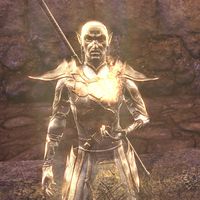
In 1E 700, with the advent of the Tribunal and the birth of the Dunmer, the people's relationship with ancestor worship was transformed. The divinity of ancestor spirits was de-emphasized, and Daedra were placed into a subservient role to the Tribunal. The good Daedra Boethiah, Mephala, and Azura were recast as the "anticipations" of Vivec, Almalexia, and Sotha Sil, respectively. Some of the more important ancestor spirits, including Veloth and Nerevar, were made into saints instead.[14][18] Temple orthodoxy maintained that the divinity of the Tribunal was conferred to them by the ancestor spirits in a communal judgmement, as a reward for their deeds and wisdom.[19]
According to Dunmer belief the spirits of the dead continue to exist in the world, being able to "know and affect the future, speak with other spirits and work great magic". The Dunmer believe that recently deceased spirits are weaker but close to the living in spirit, quick to guide and protect, whereas older spirits are stronger but stranger and more distant, with the Daedra being the oldest and greatest but also strangest of such spirits. Malevolent spirits are considered "daemons and "devils" from whom benevolent " Hero" spirits protect.[13][14] Ancestor spirits are known to grant the living boons such as protection from harmful magic[20], blessings[21] and oracular knowledge which sometimes even deities lack.[22] As a sign of great honor and sacrifice, an ancestor might ask that their remains be interred into a clan Ghostfence to shield the family's shrine.[23]
Dunmer believe that their spirits persist after death, and are bound to their families. This relationship with the ancestors and their ghosts is extremely intimate and personal, but also quite serious as they feel that all that they think and do is under the watchful eye of the ancestor spirits.[24] Marriage does tie one to their new family, as the bond to the ancestor is partly blood and partly volitional ritual, but less strongly than blood—a spirit's blood family will always be able to access them. Family spirits sometimes manifest physically to grant boons or advice, but most hate doing so. They sometimes manifest in a form with physical substance and sometimes not, but retain their magical expertise. When they manifest, they experience a painful phenomenon known as the Mortal Chill. The Mortal Chill often drives such spirits insane, and these "Mad Spirits" are purposefully employed as servants and guards by the Temple.[23][25][26]
In return for these boons, families are oath-bound to pay respect to their ancestors. To that end, in the times prior to the Blight, each family kept a family shrine—little more than a hearth, for poorer families—where family relics are venerated. This shrine is sometimes called The Waiting Door, representing the door to Oblivion. However, their ancestors' actual remains were ideally sent to a mausoleum known as a City of the Dead, the most famous being at Necrom. Sometimes, pieces of an ancestors remains were used to construct a family ghostfence—a magic wall that draws spiritual energy to itself to barricade family holdings.[23][27]
Dunmer have historically drawn a strong distinction between Necromancy and the "Spirit Magic" employed by the Tribunal Temple. Though both involve summoning and manipulating the undead, Spirit Magic is generally viewed as sacred, whereas Necromancy is perceived as impure.[28] Even then, there are exceptions. Prior to Morrowind entering the Empire, Telvanni Necromancy was considered perfectly acceptable, as long as their targets were animals or non-Dunmer. The Dunmer cultural view of necromancy was seen as hypocritical by many outside the Temple, and also served to elevate tensions with the Third Empire, where necromancy was legal.[23][28][29] Bonewalkers and Bonelords are a type of undead created through sacred ritual; the rituals used to create these undead are not considered to be necromancy in Morrowind.[29][23] Due to those beliefs, both the Tribes and the Temple believed that forcefully summoning the ghosts of the ancestors was a shameful and sinful act as it not only made them slaves but also took the spirits out of their own world. The Dunmer did often consider it cruel to take the spirits even if it was done out of their own will in service and love to family and their race, but it was seen as much worse if it was forceful necromancy, with the action not being tolerated in Morrowind in general.[30]
By 3E 427, with the return of Dagoth Ur and the coming of the Blight, Dunmer ancestor worship was forced to change yet again. By order of the Tribunal, the vast majority of all ancestors' remains were redirected to the Great Ghostfence surrounding Red Mountain. The Temple began to decry previous traditions as selfish, and family shrines fell into disuse as no new people were allowed to be buried in them. Instead, local temples were permitted small amounts of each persons' remains, and their families were encouraged to worship there instead.[23][31]
After the defeat of Dagoth Ur, the Ghostfence's barrier was no longer necessary, and was deactivated. This signaled an end to the need for new remains, and the Ghostgate itself became a monument to the dead.[31][32] However, the impact on ancestor worship and family tombs is uncertain, as the disappearance of the Tribunal may have led to the rise of other factions such as the Imperial Cult.[33]
Some House Dunmer carried an ancestral urn and a folding altar with them on their travels to worship abroad. These urns were often quite fancy, with some being made of pewter with gold filigree.[35]
Ashlander Tribes[edit]
Not all Dunmer would accept the Tribunal's reforms. Even after the emergence of the Tribunal Temple, tribal Ashlanders continued to hold to the Old Ways of ancestor worship. For this, they were initially perceived by both House Dunmer and outlanders alike as barbaric and shamanistic.[36][37]
Though Ashlanders recognized Nerevar as a House Dunmer, he was still revered for honoring the Ancient Spirits and preserving Tribal Law.[17][15] After his death at the battle at Red Mountain, Nerevar's shield-companion, Alandro Sul, accused the Tribunal of orchestrating his murder and achieving apotheosis through necromancy. Following his teachings, the Ashlander tribes rejected the Tribunal's religious reforms and subsequently faced millennia of persecution from the Temple.[36][38]
Ashlander religious traditions bear some broad similarities with Temple Ancestor Worship. For example, Ashlanders believe the spirits of the strong persist after death and beseech them for wisdom. Ashlanders also maintained ancestral burial grounds, which they continued to use even as the practice declined among House Dunmer due to the Ghostfence.[39] Unlike the Temple however, Ashlanders never purposefully employ Mad Spirits as guards or servants, instead fearing them as ghosts, devils, and daemons.[13] Additionally, they believe that any manipulation of the bodies or spirits of ancestors is necromancy, and therefore that the Spirit Magic of the temple is an abomination.[28] Unlike House Dunmer, the Ashlanders often mummify their dead using ash salts.[40]
Each tribe is said to maintain a tribe-specific Ancestor Cult, which venerates the heroes and leaders of their own tribe above other ancestors. A tribe's religious rites are led by a female shaman known as a Wise Woman who, in addition to communion with ancestor spirits, is also charged with preserving a tribe's oral history.[13][37] Some Wise Women have additional unofficial duties from placating angry spirits to counseling Ashkhan, or even leading in their absence.[41]
All Ashlanders venerate Nerevar as an ancestor and pass down some of his prophecies, but the Urshilaku Tribe in particular is noteworthy for hosting the Nerevarine Cult.[42] The Nerevarine Cult believed that a reincarnation of Nerevar would return to cast down the Tribunal Temple, cast out the foreigners, and restore Morrowind to the Old Ways of ancestor worship.[29][17] Those who attempted, but failed, to fulfill all seven prophecies related to the return of Nerevar were known as "false incarnates", and their spirits are venerated in the Cavern of the Incarnate. In 3E 427, Nibani Maesa, then-Wise Woman of the Urshilaku, helped the Nerevarine achieve recognition as the true reincarnation of Nerevar.[43][44]
Some Ashlander tribes are known to take action to neutralize maddened ancestors, warning of the danger such spirits pose, and seeking out those dangerous spirits who remove the souls of the living to enthrall their spirits and steal their bodies, killing their possessed vessels to confine their souls to a location it becomes bound to. [45][46] Thus neutralizing the spirit even though ghosts merely lose the energy they used to manifest rather than die when slain.[47]
Dissident Priests & the New Temple[edit]
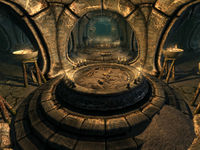
A faction from within the temple known as the Dissident Priests took to recording Ashlander religious practices and oral history—including the Nerevarine prophecies. The Dissident Priests questioned the divinity of the Tribunal and historicity of the Temple's official narrative of the Battle of Red Mountain. Many saw studying Ashlander teachings as one way to pursue the truth.[19][48][49]
The Temple official position was that Ashlander beliefs were heretical, with suppression of the Nerevarine Prophecies receiving special attention.[49] For this reason, the Dissident Priests too were persecuted for recording and studying the Nerevarine Prophecies. The Temple's justification was that dissent from within the clergy weakened the people's faith and therefore the Tribunal's efforts to combat Dagoth Ur.[49][48] However, following the return of the Nerevarine, this official persecution came to an end by order of Vivec.[38]
Like the Ashlanders, Dissident Priests called for a return to the Old Ways of ancestor worship. Unlike the Ashlanders however, the Dissident Priests still had a fundamentally positive view of the Tribunal. Though they called for reform in how the Temple employed force, they still believed that the Tribunal and the core of Temple doctrine was fundamentally good.[19]
In 4E 5, following the devastation of the Red Year, the Temple and Dunmer society as a whole entered a period of reorganization. While most of the records from the transition period are lost, by 4E 201, the Dissident Priests had formed the New Temple. As the Old Temple had once done to Veloth, the Tribunal were demoted to saints, and the temple once again returned to the Old Ways of ancestor worship. By this time, the use of family shrines and ancestral tombs appeared to once more be commonplace.[50] The New Temple no longer persecuted Ashlanders, instead praising them for having the "true vision" to continue practicing the Old Ways. Adherents of the New Temple often make pilgrimage to seek the wisdom of an Ashlander Wise Woman.[51]
Despite the majority of the Dunmer people turning away from Tribunal worship, Almsivi were still revered as gods by certain sects. These devotees were regarded as heretics by the New Temple and were persecuted for their beliefs.[52] One cult of Almalexia worshippers constructed a hidden temple to the Tribunal in a cave on Solstheim known as Ashfall's Tear, just north of Raven Rock. The cultists raised a giant statue to the Goddess Almalexia and planned to use old propaganda to restore widespread Tribunal worship.[53][54] Circa 4E 201, the Last Dragonborn was alerted to the cult's existence, although it is unknown if the Dragonborn aided the cult or destroyed it.[53]
Ayleid[edit]
Ayleids were known to place a great deal of spiritual importance in their ancestors.[55] Chief among those were the Ten Ancestors, famously represented as ten statues wrought from meteoric glass and iron. The White-Gold Tower, which the Ayleids called the Temple of the Ancestors, was constructed in-part to house these statues.[56]
Veneration of the Ten Ancestors was historically a key part of Ayleid religion. They were so culturally ubiquitous that it even became traditional to structure books in 10 chapters to honor them.[57] Even following the Narfinsel Schism,[58] which split Ayleid religion along Aedra-Worshipping (Barsaebic) and Daedra-worshipping (Daedraphile) lines, ancestor worship appeared to remain important to both sides of the conflict. The Daedraphiles continued to venerate the Ten Ancestors, but now held that the ancestors had likewise been Daedra worshippers. Holy texts, such as The Eleven Edicts of the Ten Ancestors, were written to reflect this.[59] For their part, even as they fled into Black Marsh, the Barsaebics also maintained their ancestor worship. Loriasel in Shadowfen was built by the Barsaebics as a temple to venerate the Ten Ancestors.[55]
The Heretic of Lindai authored The Eleven OTHER Edicts of the Ten Ancestors—a parody of the Eleven Edicts which asserted, among other things, that the Ten Ancestors had worshipped Auri-El.[59]
Worship of the Ten Ancestors declined with the Ayleids. When the Alessian Slave Rebellion began, the statues were hastily removed from the White-Gold Tower and sent to various Ayleid kingdoms for safekeeping. The statues would not be reunited again until 3E 433, when the Altmer scholar Umbacano located them with help from the Hero of Kvatch[60]
Some texts suggest the methods used by the Cult of the Ancestor Moth to read the Elder Scrolls might've originated from the Ayleids.[61]
Redguard[edit]
—The Improved Emperor's Guide to Tamriel
The origins of Redguard Ancestor Worship is unclear. Some believe this ancient tradition began after the Yokudans settled in Hammerfell. They noticed that corpses decomposed very slowly in the desert, and over time the people assigned a spiritual significance to the process and declared that the remains of their ancestors were sacred.[62] Other sources claim Ancestor Worship was the most sacred law and tradition of the ancient Yokudans.[63]
Redguards are famous not just for their many religious rituals surrounding the dead, but also for the elaborate necropolises they build to house them. At these sacred sites, supplicants give prayer not just to their own direct ancestors, but also historical Redguard kings and the untold number of Yokudans who perished when the continent sank.[64]
In addition to performing continuing rites for dead ancestors in general, Redguards also specifically honor the spirits of Sword-Singers. Multiple temples (perhaps most notably Tu'whacca's Throne) host the spirits of departed Ansei who remain to pass on their wisdom to supplicants. Religious rites, such as the Trials of the Hero, are used to contact them and gain their favor.[65] Some Ansei have become associated with gods, such as Frandar Hunding who is often referenced together with HoonDing, the make-way god.[66][67][68]
Redguards are especially disgusted by necromancy, which they see as profaning the honored dead. As bringing any harm to the honored ancestors is considered sacrilege, many Redguard warriors refuse to even defend themselves against undead.[62] A set of holy artifacts known as the Ansei Wards is meant to protect consecrated dead in the Alik'r from necromantic rituals. Even so, multiple necromancers and even the Imperial Legion have been able to leverage the Redguards' unwillingness to hurt the undead to their own advantage.[69][64]
A secretive tribe of pariahs known as the Ash'abah are dedicated to the taboo task of purifying angry ancestor-sprits and saving Hammerfell from necromancers.[64] Ash'abah methods of slaying the undead often involve repeated ritual apology, so as not to disrespect the ancestors.[70] Despite their service being widely considered necessary, the tribe is still reviled by the wider Redguard society for hurting the undead. Even the act of speaking to an Ash'abah is treated as profaning oneself.[62]
Bosmer[edit]
Some spirits can come to serve specific functions on the behalf of gods, becoming their emissaries to the world of the living. Aedric deities such as Z'en have been known to choose spirits to act as their heralds, tasking them with duties such as assigning and collecting the debts of the faithful in regards to his sphere of payment in kind. Such spirits might appear to the living to offer guidance, or pass judgement, and are revered by the faithful as instruments of divine will.[71][72]
The Elders of Bramblebreach are the ancestor spirits of the modern-day Bramblebreach Clan. Though they are largely seen as a child's tale, they are considered one with the Wilderking Court and provide wisdom when needed.[73][74] The Vinedusk Rangers honor past members and especially revere their founder, Nendaer the Ironbark. One ranger can be quoted with "Rangers don't forget Rangers. Not now, not ever."[75][76]
Tsaesci[edit]
The Tsaesci religion is one of ancestor worship. They believe that all waterways connect the worlds of the living and the dead and from them the spirits of their ancestors gaze upon their living descendants and their deeds,[77] thought to grant either good fortune or misfortune depending on whether the actions of their progeny have pleased them. One's ancestors are invoked by calling their name during the Proving Festival, a date on which it is said it is possible for spirits to cross over from the afterlife into the living world. Ancestor spirits are said to grow more powerful the more they are revered, thus a well-honored ancestral spirit will be able to cross from the afterlife into the living world more easily, take on different forms such as that of a black bladed golden warrior that is "swift as the wind", grant great fortune or misfortune, commune through and alter dreams, and even drag one to the afterlife if angered. Thus ancestor spirits are viewed as something to be appeased, able to render significant aid if properly honored but also dangerous if offended, known to deliver potentially fatal trials for what they consider insulting behaviour such as verbal boasts of greatness that disrespect the dead.[78][79][80] Spirits might also return to the living world for other reasons, such as taking action to maintain their own legacy, whether based on truth or not.
Hakoshae, a community of Imperials claiming Akaviri descent, maintained what they believed was the Tsaesci tradition of ancestor worship. In 2E 582, they revived the Proving Festival—an Akaviri holiday where supplicants prove their wisdom, strength, and honor to their ancestors.[81][82]
Cult of the Ancestor Moth[edit]
Some Nedic texts suggest the methods used by the Cult of the Ancestor Moth to read the Elder Scrolls might've originated from the Ayleids. The Nedic slaves were tasked to tend to the reading rooms within the White Gold-Tower, where the elves made use of the Ancestor Moths and Canticle Trees to learn how to master the world from the Elder Scrolls in their possession. When the Ayleids realized their slaves could also hear the song of the moths, they decided to teach them the secrets of how to read the Scrolls, so as to have them perform the readings and bear the burden in their stead. In secret these Nedic moth tenders spirited away the components of the reading ritual and established their own sacred glades, beginning the tradition that gave rise to the Cult of the Ancestor Moth. There are those within the Cult that believe the secrets of reading the Scrolls were taught by Akatosh, or that the moths were first stolen from the Hunting Grounds.The Tradition of naming the Elder Scrolls is said to have also started with the Ayleids, though some within the Cult of the Ancestor Moth are skeptical of this claim.[61]
According to the Cult of the Ancestor Moth, mortal souls are the Aedric essence at the core of every mortal's existence. They can be likened to the wings of a butterfly, scaled and full of vessels which become filled with the experiences of mortal existence. It is said that upon death a process of dissipation whereby some of these accumulated contents disperse. These essences, the Fjyrons or "will to peace", are believed to retain a connection to both the grand fabric of creation and to all aspects of the soul in all their destinations. Thus because, all aspects of a soul remain connected, tapping into the Fjyrons allows one who knows how to receive the erudition of the ancestors. Knowledge and guidance from beyond mortality, from the existence beyond the present and the past and the known world, where time is irrelevant, thus allowing one to glimpse the cosmic tapestry and its threads. The Ancestor Moths of the Order are said to imbibe the Fjyrons, described by some as the memories of the dead,[83] becoming animated by the Fjyrons of the ancestor spirits, shepherding that wisdom and passing it through the generations. Thus the moths represent a connection to the Aedra and the "endless Aedric coil of mortal souls" through the experiences of every mortal who has ever lived, and their trilling forms a sort of primal augur which allows the Order to read and interpret the contents of the Elder Scrolls which contain knowledge said to exceed even the gods.[84][85][86][87][61]
Fjyrons can be sung into the silk produced by the Ancestor Moths. When the silk is spun into cloth and embroidered with the genealogy of the appropriate ancestor, it creates garments of extraordinary power. Members of the Order of the Ancestor Moth honor and celebrate their ancestors, whose spirits are embodied in the Ancestor Moths, and possess the knowledge to weave this essence into their creations.[85] The tradition of weaving Ancestor Silk originated with the early Cyro-Nordic tribes of the Nibenay. Today, their descendants, the modern-day Nibenese, continue this sacred practice, creating vestments and other garments. The swishing of this material is said to produce a "resplendent ancestral chorus," which has inspired this ancient custom.[86] The silk is highly prized throughout the Empire and is exported alongside other valuable goods.[83] Some people pay weavers to craft shawls inscribed with their family trees, believing that these garments hold the memories of their ancestors.[83] Monks of the higher orders in the Cult of the Ancestor Moth can bypass the magical rituals typically required to enchant this fabric and often choose to wear the moths around their necks and faces instead.[86]
Other Traditions[edit]
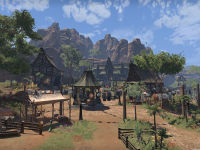
The Nords honor their ancestors and place offerings in or at their graves. Apples, wine, gold coins or snowberries are often offered to the ancestors.[88]
Like the Redguards, the desert-dwelling Khajiit were also once known for their massive necropolises where they would give offerings and prayer to their ancestors.[89] Some adeptoriums also communed with ancestor spirits for advice. However, this kind of ancestor veneration had largely died out in Elsweyr by the mid-Second Era.[90] Even popular culture heroes like Khunzar-ri found their tombs falling into disrepair.[91]
On the last day of every year, Imperials observe the Old Life Festival, a holiday about giving offerings and passing messages to ancestors and dead loved ones.[92]
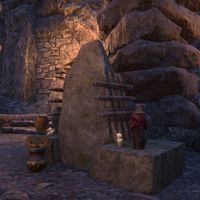
An Orcish religious order known as The Wrathful Flame performed a decennial pyre-burning ritual in the ruins of Old Orsinium for a time. They communed with Malacath by giving praise to and cursing the ancestral clans of Orsinium, symbolically keeping their desire for vengeance alive through generations of their descendants. In 2E 582, the ritual was interrupted when their members were killed by Reachmen. The Soulless One completed this ritual, but it is unknown what became of the order in subsequent years.[93]
The Reachmen have a class of story-tellers called vateshran. Their job, among other things, is to ritualistically commemorate the dead ancestors of the clan through song.[94] Reachfolk honor their ancestors by living the life the way they did and believe that their ancestors observe them from the sky above and await reunion during which the stories of the battles their descendants fought will be exchanged.[95] Some of the clans ritually sacrifice animals as a form of offering to the ghosts of venerated ancestors and ancient heroes.[96]
The Spiritblood Clan have their children undergo dangerous trials (called the Vateshran's Rites) as a rite of passage. Those who emerge become fully-fledged members of the clan, and earn a vateshran song that will last forever.[94] The Lamenter of the Slain, one of the proctors of the trial grounds, performs rites on behalf of all who have died during their Vateshran's Rites. Warriors of the Spiritblood who fell defending the ways of their ancestors are honored by having Totems of the Brave erected in their honor.[97] One ancestor spirit in particular—Aydolan, the clan's first Vateshran—personally guides prospective challengers.[98] One of the many other clans of the Reach believe that their ancestors bring them messages through one specific breed of snowy bunnies.[99]
One theory about why minotaurs gather around Alessian ruins is that protecting them is a form of veneration for Belharza (or Morihaus, Alessia, etc.).[100][101]
The Psijic Order have declared centaurs "true followers of the old ways", referring to the complex system of ancestor worship that Artaeum itself espouses.[102]
Ancestor worship was a focal point in Breton religion from antiquity. The Daggerfall holiday known as the Day of the Dead is believed to come from this.[103]
Many reports from across Tamriel describe a phenomenon where the souls of the dead adopt a variety of forms to return and speak with the living. Animals, plants, or even fearsome visions, are all reported manifestations. It is theorized that the Luminaries, immortal beings of pure magic, might have originated as mortal souls, being the spirits of Ascended Ancestors that transformed into their current state after death due to this described phenomenon. As the Luminaries themselves can't recall their origins, this theory remains unproven.[104][105] Whatever the case, however, a Luminary can indeed be created out of the essence of a mortal soul, as was the case with the Crow Luminary, who was created through a ritual devised by Ulfsild the Evergreen out of a portion of her own essence. Though the process is straining and the restoration of the spirit takes time, a soul that was used in such a manner will eventually recover.[106]
In 2E 582 the members of a group of ghost hunters claimed to have located ancient texts which spoke of a time before memory and contained the secrets of divinity. The texts are said to have spoken of the existence of divine beings known as the Old Gods, originating from a time before the memory and the languages of mortals. It is said that these beings were once themselves inhabitants of Nirn, who walked the world during a time when mortal and immortal lived side by side, but eventually achieved perfection and left the mortal world behind. The spirit hunters claimed that whoever studied this faith could eventually achieve this same transcendence and thus one shouldn't cling strongly to material things, they attempted to spread this faith. Despite claiming to wish to teach others the path to ascension, the adherents would teach of their faith only for monetary compensation, and call to other deities such as the Divines in moments of panic, potentially implying their discoveries were fabricated and their claims disingenuous.[45]
Gallery[edit]
See Also[edit]
References[edit]
- ^ Events of Divine Conundrum in ESO
- ^ a b c Varieties of Faith — Brother Mikhael Karkuxor of the Imperial College
- ^ a b The Changed Ones
- ^ The Onus of the Oghma — Phrastus of Elinhir
- ^ The Monomyth
- ^ The Old Ways — Celarus the Loremaster
- ^ Aedra and Daedra
- ^ a b c d e Pocket Guide to the Empire, 3rd Edition: The Blessed Isle: Alinor and the Summersets — Imperial Geographical Society, 3E 432
- ^ The Old Ways — Celarus the Loremaster
- ^ a b Daedra Worship: The Chimer — Phrastus of Elinhir
- ^ a b Exodus from Summerset
- ^ Generic dialogue regarding Altmer in Morrowind
- ^ a b c d Generic dialogue regarding Ancestors in Morrowind
- ^ a b c Veloth the Pilgrim — Cascius the Proud
- ^ a b c Nerevar Moon-and-Star
- ^ Nerevar at Red Mountain — the Tribunal Temple
- ^ a b c Generic dialogue regarding the Nerevar in Morrowind
- ^ The Anticipations — Anonymous
- ^ a b c Progress of Truth — Dissident Priests
- ^ Saint Veloth's dialogue in ESO
- ^ Shrines in Morrowind
- ^ Events of Divine Conundrum in ESO
- ^ a b c d e f Ancestors and the Dunmer
- ^ Reflections on Cult Worship — Cuseius Plecia
- ^ Mavos Siloreth's dialogue in ESO
- ^ Spectral Knights's appearance in ESO
- ^ The Waiting Door — Canon Nileno Nirith
- ^ a b c Generic dialogue regarding Necromancy in Morrowind
- ^ a b c Sharn gra-Muzgob's dialogue in Morrowind
- ^ Blasphemous Revenants
- ^ a b Generic dialogue regarding the Ghostfence in Morrowind
- ^ Generic dialogue regarding the Ghostgate in Morrowind
- ^ Avrus Adas' dialogue in Oblivion
- ^ Shelreni Baro's spirit in ESO
- ^ Filigreed Ash Urn with Portable Altar item description in ESO The Keepers of the Dead are known to administer rites to usher the spirits of restless ancestors to the afterlife.[34]
- ^ a b Generic dialogue regarding Ashlander Culture in Morrowind
- ^ a b Generic dialogue regarding the Ashlanders in Morrowind
- ^ a b Vivec's dialogue in Morrowind
- ^ Meet Sul-Matuul quest in Morrowind
- ^ Urshilaku Burial Caverns in Morrowind
- ^ The Trial of the Ghost Snake quest in ESO
- ^ Caius Cosades' dialogue in Morrowind
- ^ Nibani Maesa's dialogue in Morrowind
- ^ The Path of the Incarnate quest in Morrowind
- ^ a b Farwen Temolire's dialogue in ESO
- ^ Ashu-awa's dialogue in ESO
- ^ Theyo Prevette's dialogue in ESO
- ^ a b Generic dialogue regarding the Dissident Priests in Morrowind
- ^ a b c Mehra Milo's dialogue in Morrowind
- ^ Elder Othreloth's dialogue in Skyrim: Dragonborn
- ^ The Reclamations — Thara of Rihad
- ^ Heretic Dossier: Blacksmith's Confessional
- ^ a b Ghosts of the Tribunal quest in Skyrim
- ^ Her Word Against Theirs quest in Skyrim
- ^ a b Loriasel loading screen in ESO
- ^ Umbacano's dialogue in Oblivion
- ^ A Life of Strife and Struggle — King Laloriaran Dynar
- ^ Ayleid Survivals in Valenwood — Cuinur of Cloudrest, 4th Tier Scholar of Tamrielic Minutiae
- ^ a b The Library of Dusk: Rare Books
- ^ The Collector quest in Oblivion
- ^ a b c Loremaster's Archive - Elder Scrolls & Moth Priests — Sister Chana Nirine
- ^ a b c King Fahara'jad's dialogue in ESO
- ^ Vizier Yeqdah's dialogue in ESO
- ^ a b c EGT — Flaccus Terentius, 2E 581
- ^ Revered Ancestors quest in ESO
- ^ Varieties of Faith, Crown Redguards — Brother Mikhael Karkuxor of the Imperial College
- ^ Hoonding's Prayer Stone contraband item in ESO
- ^ Hoonding's Golden Quill contraband item in ESO
- ^ Sacrilege and Mayhem in the Alik'r — Doctor Tazhim of the Bureau of Outlander Affairs
- ^ Correct Ways of Slaying Ra-Netu: 12
- ^ The Emissary of Z'en's appearance and dialogue in ESO
- ^ Mathragor's dialogue in ESO
- ^ Elders of Bramblebreach
- ^ Doriel's dialogue in ESO
- ^ Captain Odreth's dialogue in ESO
- ^ Sergeant Herdor's dialogue in ESO
- ^ Domitia Nasica's dialogue in ESO
- ^ Clever Kail-Perwa and the Great Boast — Nalae-Polek, Poet Laureate to Potentate Versidue-Shaie
- ^ Proconsul Beloren-Kaie's appearance in ESO
- ^ The Proving Festival — Laije-Palak Rulician
- ^ Magnate Feina-Darak's dialogue in ESO
- ^ Descendant of the Potentate quest in ESO
- ^ a b c Ancestor-Silk Shawl item description in ESO
- ^ The Distributed Soul — Abbot Crassius Viria
- ^ a b Pension of the Ancestor Moth
- ^ a b c Pocket Guide to the Empire, 1st Edition: Cyrodiil — Imperial Geographical Society, 2E 864
- ^ Ancestor Moth Swarm's pet name in ESO
- ^ Offerings in Hillgrund's Tomb in Skyrim
- ^ Relatively Speaking quest in ESO
- ^ Jora-ri's dialogue in ESO
- ^ Khunzar-ri's dialogue in ESO
- ^ Petronius Galenus' dialogue during Old Life Observance in ESO
- ^ Flames of Forge and Fallen quest in ESO
- ^ a b The Rites Matron's dialogue in ESO
- ^ Ardanir's dialogue in ESO
- ^ Great Spirits of the Reach: Volume 2 — Vashu gra-Morga, Chief Daedrotheologist at the University of Gwylim
- ^ Lamenter of the Slain's dialogue in ESO
- ^ Vateshran's Rites quest in ESO
- ^ Powderwhite Coney's description in ESO
- ^ On Minotaurs — Nonus Caprenius, Temporarily Unaffiliated Scholar of Imperial Antiquities
- ^ The Minotaur Song
- ^ Daggerfall User's Guide
- ^ Holidays of the Iliac Bay — Theth-i
- ^ Loremaster's Archive - Scribing — Votary Nahila
- ^ Ulfsild's Notes: The Origin of Luminaries — Ulfsild
- ^ The Crow's dialogue in ESO
Note: The following references are considered to be unofficial sources. They are included to round off this article and may not be authoritative or conclusive.
- ^ The Thief Goes to Cyrodiil — Vivec
| |||||||||||||||||||||||||||||
| ||||||||||||||||||||
